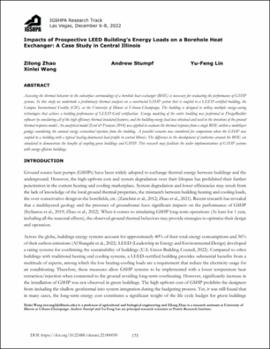| dc.contributor.author | Zhao, Zilong | |
| dc.contributor.author | Stumpf, Andrew | |
| dc.contributor.author | Lin, Yu-Feng | |
| dc.contributor.author | Wang, Xinlei | |
| dc.contributor.other | IGSHPA Research Track (2022) | |
| dc.date.accessioned | 2022-12-04T22:10:05Z | |
| dc.date.available | 2022-12-04T22:10:05Z | |
| dc.date.issued | 2022 | |
| dc.identifier | oksd_igshpa_2022_zhao | |
| dc.identifier.uri | https://hdl.handle.net/11244/336852 | |
| dc.description.abstract | Assessing the thermal behavior in the subsurface surroundings of a borehole heat exchanger (BHE) is necessary for evaluating the performance of GSHP systems. In this study we undertook a preliminary thermal analysis on a constructed GSHP system that is coupled to a LEED-certified building, the Campus Instructional Facility (CIF), at the University of Illinois at Urbana-Champaign, The building is designed to utilize multiple energy-saving technologies that achieve a building performance of LEED-Gold certification. Energy modeling of the entire building was performed in DesignBuilder software by considering all of the high efficiency thermal-insulated features, and the building energy load was obtained and used in the iterations of the ground thermal response model. An analytical model (Erol & Francois 2018) was applied to evaluate the thermal response from a single BHE within a multilayer geology considering the annual energy extraction/rejection from the building. A parallel scenario was considered for comparison when the GSHP was coupled to a building with a typical heating-dominated load profile in central Illinois. The difference in the development of isotherms around the BHE are simulated to demonstrate the benefits of coupling green buildings and GSHP. This research may facilitate the wider implementations of GSHP systems with energy-efficient buildings. | |
| dc.format | application/pdf | |
| dc.language | en_US | en_US |
| dc.publisher | International Ground Source Heat Pump Association | |
| dc.rights | In the Oklahoma State University Library's institutional repository this paper is made available through the open access principles and the terms of agreement/consent between the author(s) and the publisher. The permission policy on the use, reproduction or distribution of the article falls under fair use for educational, scholarship, and research purposes. Contact Digital Resources and Discovery Services at lib-dls@okstate.edu or 405-744-9161 for further information. | |
| dc.title | Impacts of prospective LEED building's energy loads on a borehole heat exchanger: A case study in Central Illinois | |
| osu.filename | oksd_igshpa_2022_zhao.pdf | |
| dc.identifier.doi | 10.22488/okstate.22.000030 | |
| dc.type.genre | Conference proceedings | |
| dc.type.material | Text | |
